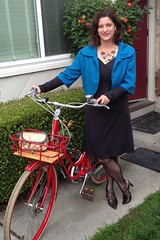Last week, Strava, the company that provides tools for cyclists to track their rides via GPS, was making the news for their Global Heatmap A project of Strava Labs, the Global Heatmap compiles GPS tracking data from 100 million rides and runs by their members (about 80% are rides). Routes that Strava users travel more frequently light up brightly on the Heatmap. In this map red is highest use, then bright green, then faint green.
The Heatmap for Palo Alto is what I’d expect. The most popular routes are a pair of roads with bike lanes that offer direct, fast routes, and a bike boulevard designed with few stop signs and diverters that reduce car traffic.

Bike advocates, who often struggle to get ridership data, jumped on the Heatmap with glee. With this data, they could refute claims that people don’t bicycle on certain roads or streets. One example: El Camino in Mountain View shows green sections, meaning significant use, something city officials and the public are quick to deny.
I see that value, and yet I’m concerned about how Heatmap data is used, namely because it’s gathered from a select subset of cyclists. Strava doesn’t reveal demographics on who uses its service, but I’ve seen estimates in reports that it’s about 90% men. And I know that within my circle of cycling friends, Strava is more heavily used by those who are training to race or complete an endurance event. They’re mostly road riders and mountain bike racers who have raced at some point, if not currently training to race.
That mirrors Strava’s goal-oriented “prove it” marketing messages highlighted on their web site: “Prove It: Track your progress and challenge your friends” and “Prove Your Story”, “Prove Your Efforts”, “Prove To Others”, “Prove To Yourself.” These are all messages aimed at the Type A folks in the bike world.

I’m sure there are significant numbers of Strava users who never race (unless you count the Cat 6 racing on the trail), and others who track both their training rides and their casual rides. But I agree with a friend who wrote: “The data is skewed to longer rides done be people who take the effort to log their ride on Strava using a smart phone or GPS. A 4 block ride for shopping or to the library is not likely to be logged.”
A bigger problem is what he wrote in the next sentence: “Since [Strava users] are likely to be more experienced riders, they tend to know the easiest, safest, fastest routes.” I accept that Strava users are more experienced riders. But are they choosing routes that are easiest and safest? Or just popular with Strava users, who likely prefer straighter routes with fewer stops, even if that means it’s on the shoulder of a 50 mph expressway with heavy vehicle traffic. That’s hardly a representative set of riders to use for bike infrastructure decisions.

Without demographic data, it’s hard to counter or defend these assessments. But I got new insight from examining “hot spots” on the Heatmap where cyclists stop on their rides, based on a story by Cyclelicious.
Here’s the Town & County shopping center in Palo Alto near Stanford University. Car parking is painfully crowded so many visitors arrive by bike. Where do they go? According to the Heatmap, these two locations: a Peet’s Coffee Shop and a bike rack around the corner by Gott’s Roadhouse, a popular restaurant.

What’s missing? The mass of people who park their bikes to shop at Trader Joe’s on the other side of the center. The main rack holds a dozen bikes and has frequent turnover. It’s often full or crowded so bikes spill over to a nearby rack at Calafia. This was the situation last Sunday at around 12:30 pm: 13 bikes near Trader Joe’s, five at Peets and four at the Roadhouse. Why don’t the bikes at TJs create a hot spot?

Sunday at 12:30 pm isn’t a peak time for groceries, nor a slow time for a coffee shop. It’s clear that people who shop by bike at Trader Joe’s are not tracking their trips on Strava. That’s a lot of everyday bike trips to ignore.
So before you’re tempted to use Strava data to support bicycle policy or infrastructure changes, think carefully. If Strava data included trips by the average Joe, Jane, José or Jin-Wei biking across town to grocery shop instead of training data from cyclists tracking achievements, how would your recommendation change?





































